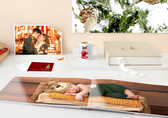Image
There are two ways to add images to your photo product within the Designer:
Before selecting a layout: Tap on the Image button in the bottom menu to open the Upload images menu. Select the images you wish to add from your device or other sources. The selected photos will be added to the workspace, and you will need to position them manually or select a layout to help with placement. For more information read the Size and Position objects article.
After selecting a layout: Once a layout has been selected and placed, an image box appears. Tap on the image box to open the Upload images menu and select your images. The selected image will automatically be placed in the image box. For more information read the Layout article.
In both cases, you can edit and adjust the image once it has been added.
“Upload images” menu
You can upload images from a variety of sources, including Your device, Dropbox, Google Drive or Saal Cloud. To access external resources, you must grant permission to the relevant account. It is possible to select multiple photos by tapping on them, they will be marked with a blue tick. To add all the images in a folder, use the Select all button. Tap the Upload images green button to complete the upload.

Delete image
To delete an image placed on the photo product, select the image and tap the Delete button at the bottom. This will remove the image from your design.
Replace image
Once an image has been placed on the photo product, it can be replaced. To replace an image, select it to display the options in the bottom menu row and tap Replace. The Upload images menu will be displayed for you to select a new image.

Swap images
If two or more photos are already placed on a photo product, you can swap their positions. To do this, select the photo you want to move, hold it, and drag it to the photo you wish to swap it with.
Image editor
You can edit an image once it has been placed on your design. Select the image and tap the Edit button in the bottom menu to access the editing tools.
At the top you will see the Quality indicator. For optimal reproduction quality, all images should be marked as very good or good. Please note that the image quality indicator only considers resolution and does not take into account factors such as blurriness or camera shake.
On the bottom you will find all the tools available, you can drag the menu to the sides to display additional tools. Select a tool to open it.
Reframe
A preview of the image with its cropping frame will be displayed, showing the image box. You can zoom in or out using two fingers and reposition the image by holding and dragging it to the desired area. In addition, the following tools appear at the bottom:
Rotate: Rotate the image 90 degrees.
Mirror vertically: Mirror the image vertically.
Mirror horizontally: Mirror the image horizontally.

Once the adjustments are made, tap the OK button to save the changes. To discard the changes, tap the Cancel button.
Enhancement
Here you can activate or deactivate the image enhancement tool. This tool applies various adjustments to improve the appearance of the image. Note that these adjustments will only be visible on the final product, not on the preview. We recommend enabling this option if the image hasn’t been retouched previously. You can also deactivate Image Enhancement by default in the Settings menu. For more information, read the Image enhancement article.
Edit
Tools to make adjustments to your photo will be available at the bottom as follows:

Brightness: Adjusts the lightness or darkness of the image.
Contrast: Modifies the difference between light and dark areas. Decreasing it can create an inverted image effect.
Saturation: Changes the intensity of the colours in the image. Decreasing saturation can create black and white images.
Blur: Applies a blur effect to soften the details in the image.
Filters
By default, filter options are displayed at the bottom, allowing you to apply various effects. To access additional tools, select the {Adjust filter} button. Along with the Brightness, Contrast, and Saturation adjustments found in the Edit tools, you will also find:

Hue: Adjusts the tone of the image to create different artistic effects.
Colourization factor: Controls the intensity of the colourization applied to the image.
Colourization: Opens the colour selector, allowing you to tint the image with a chosen colour.
Frame
This option allows you to add frames to the image. Depending on the frame chosen, various customization tools will become available at the bottom, including options for adjusting opacity, colour, and thickness.

Shadow
Allows you to add shadows to images. By default, you will be presented with preset options. However, once selected, you can further customise the shadow’s opacity, colour, angle, distance from the image, and blur.

















